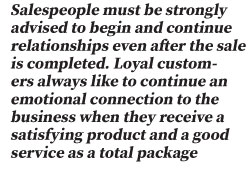
‘It is easier and cheaper to sell to existing customers than to get new ones’ is a proved fact accepted by the business community.
Hence, retaining a customer through excellent service delivery is the best option for companies to increase revenue at the lowest expenditure.
Providing good customer support is not a secondary matter to the sales effort, and certainly, it is not only helping customers on issues arising after the purchase is done. Although, the two departments, sales and customer service, are separate operationally, both departments provide support to sales. Successful companies use the support team to drag existing customers back to the sales teams to get more sales revenue.
Aligning sales and customer care teams is one of the most important factors to increase the sales pace and customer retention effort. This act can provide more results if the transition is smooth. Hence, they should operate in harmony and help each other in multiple approaches as both departments work directly with customers more than any other section of the business.
Although the salespeople make the initial contact and make a sale, the immediate intervention of the customer support not only creates a more enjoyable experience to the buyer but also starts a lasting loyalty and relationship as well.
Based on my long experience in selling, I can safely declare that when a customer purchases a product or service from a company, he is paying for the service as well. Customers’ usual expectation is to gain benefits from the whole process, not only from the purchased product. When both departments are integrated, the organisation can offer a more positive experience to the customer.
Often salesmen assume that when a sale is completed the responsibility is automatically transferred to the service team. As a career salesman, I had the same notion when I was involved in ‘field selling’. The conception is that the salesman has to immediately focus on the next sale due to the pressure of the invariably present sales targets. Therefore, salesmen most often attempt to pass the buck to their service team.
New era
However, with the grueling competition in the market today, the sales team must be educated to seriously invest in customer relationships. The era where a salesperson can close a deal and walk away is long gone with customers’ heavily enhanced knowledge of the competition due to the easy access to information through the digital media.
Salespeople must be strongly advised to start and continue relationships even after the sale is completed. Loyal customers always like to continue an emotional connection to the business when they receive a satisfying product and a good service as a total package. Therefore, an effective communication flow between sales and customer service team members is an essential ingredient.
On the other hand, another distressing factor regarding this combination is that the customer service team’s habitual lack of knowledge of the sales process. Educating the service team in the basic process practised by the sales team is essential to mingle the two teams.
The expectation must be properly shared by the members of the sales and service teams to derive the best for the organisation. Therefore, before the ‘sales to service handoff,’ the salesman must be aware of the role played by his service counterpart, and in reverse, the customer service staff must thoroughly understand the basic sales process of the company.
Customer service and sales teams must be encouraged to exchange information genuinely. At the time of transition, documentation exchange always takes place. The information the customer service team receives must be returned to the sales team back again to analyse for future sales efforts. Concerning repeat sales, information can be used to formulate future strategies.
Future sales
As a practice, customer service teams exchange more documents with customers than other sections of a company. Therefore, sharing such documents or conversations with the sales team helps to keep in touch with them on future sales. Various software programs are now available to assist in this effort.
Because of the constant communication of customer service with customers, they are ideal to assist up-selling and cross-selling activities. With the regular updates about customer service information, they can introduce other products or services of the organisation.
As communication on customer service is based on helpful and relevant information, the customer does not feel that the company is trying to dump something on them.
This method has a distinct advantage over a normal up or cross-selling attempt.
The customer service team is the best to generate customer referrals that are enormously essential in today’s ferociously competitive markets. With easy access to digital information, more and more customers tend to accept referrals of third parties. Hence, reviews and testimonials can go a longer way than any paid advertisement in building loyalty.
When the service department continues interaction with a customer, they invariably develop a sense of trust. By building a strong relationship with a satisfactory service, they also build lasting credibility that usually customers are fond of and often willing to help the organisation if the need arises.
These customers can bring in leads to the sales team by way of recommendations.
The handoff process from sales to service is also an important aspect of this subject.
At the time of handover, the leaderships of sales and customer service must work in one direction with a single goal. Successful companies that are aware of the importance of the process blend the two departments at this stage for an efficient handoff.
Single goal
Customer success is to consider sales team targets and those targets to be included in the service team’s retention efforts and goals. When a single goal exists between the teams with collective inputs, customers can witness the success and tend to accept the company with trust. The advantage for the sales team is that they can obtain repeat sales and the service team can help up-sell or cross-sell effectively. Hence, three vitally important aspects of the organisation take place when customer satisfaction, repeat sales, and up-selling and cross-selling are done.
The sales process does not end when an invoice is raised or a payment is made. The sale ends when the customer buys again and automatically starts a new sequence again. Therefore, it must be sales and customer service always; it is not a competition but integration.
With the same values being accepted and practiced by the staff, such integration can be the driving force of the organisation, resulting in overall customer satisfaction. When the overall objective is aligned with these two vital sections, sales, and customer service, it provides the best outcome, quality products, and excellent service.
In modern markets, customers are aware of whether the company’s sole intention is to make profits or provide a good product to fill a need for customers with satisfactory customer service
If the organisation is genuine in their ultimate objective of making profits by offering a good product and service, the good result is inevitable. Modern customers can differentiate and will stick to the more authentic company, according to their analysis.
